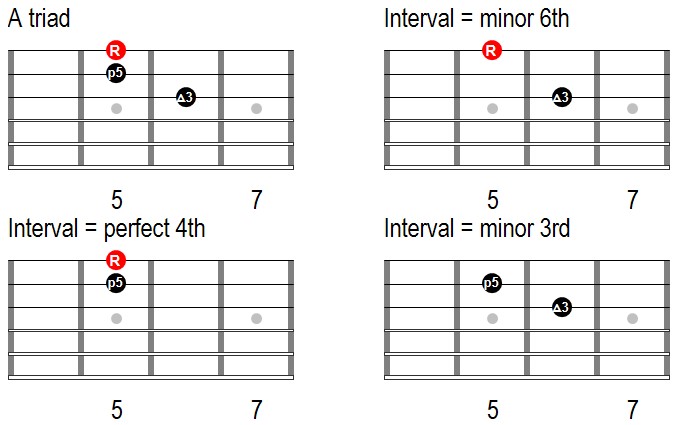I’ve recently been working on a couple of blues studies that involve the use of harmonised thirds, sixths, fifths etc.
They seem to come up mainly within triads played on the first 4 strings.
I understand the idea and the theory behind most of it but things get a bit hazy when we get on to the bottom 2 strings.
In particular the inverted triad played on the bottom 3 strings which is taken from the E shape from CAGED.
EG: A triad played on 5th fret E string, 5th fret B string and 6th fret G string.
If i remove the third and simply play strings 1 and 2 i seem to be playing a harmonised 5th?
A (Root) and E (5th)
However i always thought you count from the lowest note up to the highest to get the correct interval?
So E,F,G,A gives a harmonised 4th?
Or because we’re counting from the root do we ignore that and call it an inverted harmonised 5th? 
Anyway it would be gold to get your input guys and girls…
Cheers
Jason
Like this:

Taking the interval from the lowest note to the highest you have a perfect 4th from the E to the A. Normally just called a 4th. This is a common double-stop.
Yes.
That is definitely the convention.It is not a one-and only rule that excludes reading intervals from high to low. But is is the usual method.
The other intervals within your CAGED triad would ordinarily just be called a 6th and a 3rd.
Hope that helps.
Cheers 
| Richard_close2u | Community Moderator, Official Guide, JustinGuitar Approved Teacher
Thank you Richard
Much appreciated 
It’s only just occured to me that the 3rd and 6th intervals are minor.
Just counting the notes from C#,D,E
I always thought a third interval but only 3 steps on the fretboard so a minor interval.
That’s where the shapes really help and I guess to look at where you start the count?
C# in the key of A is minor so subsequent intervals will be minor?
I’ll be back.
More to say on this!

Great!
I’m also seeing how the same minor third interval we see in the A chord can be moved around in the context of a D shape 7th Chord.
The open Low E is often played with 3rd fret second string (D) and 4th fret 3rd string (B)
In the blues giving an E7
So In context of that shape 5 and b7 with the open low E thrown in.
Amazing what you see when you start analysing what you’re actually playing 
![]()
